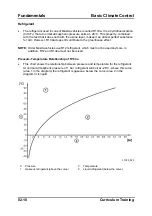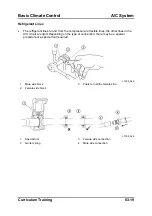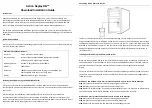
A/C System
Basic Climate Control
Condenser
•
The condenser receives heated refrigerant from the compressor and reduces the
temperature, thereby liquifying it. Refrigerant normally boils at –26°C, but under pressure
the boiling point is increased, so accordingly the condensation point is increased. This
means that as the relatively cool outside air passes the condenser, it absorbs the heat
from the refrigerant, allowing it to change state. As a result, the air passing by the fins of
the condenser increases in temperature as it absorbs the heat from the refrigerant.
•
The condensation process is plotted on the graph below. Point 2 represents the stage in
the A/C system after the refrigerant has left the compressor and before it enters the
condenser. At this point the refrigerant is a high pressure, high temperature gas.
Between 2 and 3 is the condensation process. Notice that the path crosses below the
liquid / gas curve; meaning at point 3 the refrigerant is in a liquid state. It should also be
noted that during condensation the pressure does not change.
Condensation Plotted on the Refrigerant Curve
L1005_023b
X Pressure
Y Temperature
1-2 Compression
4-1 Vaporisation
2-3
Condensation
5
Refrigerant liquid / gas curve
3-4
Expansion
(above is gaseous, below is liquid)
•
The three different types of condensers are explained on the following pages. The
condensers are all mounted forward of the radiator.
03-8 Curriculum
Training
Содержание CT-L1005
Страница 1: ...Training Manual Basic Climate Control CT L1005...
Страница 20: ...Fundamentals Basic Climate Control Notes 02 14 Curriculum Training...
Страница 52: ...A C System Basic Climate Control Notes 03 32 Curriculum Training...
Страница 66: ...List of Abbreviations Basic Climate Control Notes 06 2 Curriculum Training...
















































